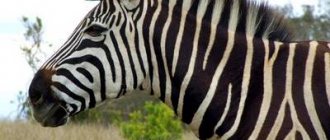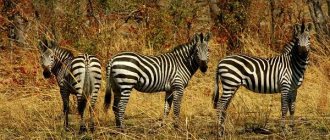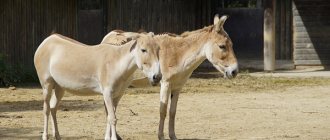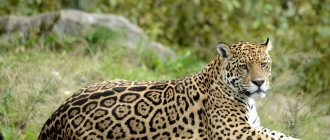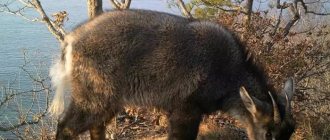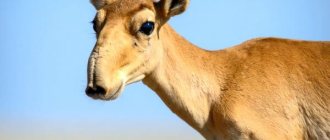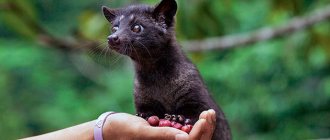Zebra species
There are several subspecies of zebras found in the world. They differ in their habitat and external features. Let's look at each of them in more detail:
Savannah zebra or Burcellova
This representative is considered the most common species. The name Burchella was received in honor of a botanist from England named William Burchella. It lives mainly on the southeastern continent of Africa.
The appearance of the savannah zebra is represented by a characteristic pattern on the skin. It may vary depending on the habitat of the animal. For this reason, about 6 subspecies of savannah zebras are distinguished.
The northern representatives are distinguished by a brighter pattern on the body, while the southern ones have a blurred pattern and have beige stripes on a white background. In size, Burchell's zebra reaches about 2.4 meters in length with a tail of up to 57 centimeters. Zebras do not exceed 1.5 meters in height with a weight ranging from 290 to 340 kilograms. The difference between the savanna zebra and the desert zebra is its smaller size and rare stripes on its coat.
Desert zebra or Grevy
The desert zebra received the name Grevy in honor of Jules Grevy, who was the President of France. He received this zebra as a gift from Abyssinia. You can meet it in the subequatorial belt of Africa in such regions as: Kenya, Uganda, Ethiopia, Somalia, Meru.
In size, Grevy reaches about 3 meters in length with a tail of another 50 centimeters. Weight is around 400 kilograms. The predominant coat color is white or white-yellow. A characteristic feature is a wide black stripe running down the middle of the back. The desert zebra's stripes are slightly thinner than other species and are black or dark brown. There are no stripes in the abdominal area.
Mountain zebra
A distinctive feature of mountain zebras is the predominance of black color and narrow white stripes. The legs also have continuation of the stripes that extend to the hooves. In terms of its dimensions, a mountain zebra can reach 370 kilograms of weight with a body length of about 2.2 meters.
There are two subspecies of mountain zebras:
Cape mountain zebra
It lives in the national parks of South Africa, as well as in some areas of the Cape of Good Hope. At the moment, this subspecies is under strict protection by the South African state due to their mass extermination in the 20th century. The appearance of this representative is distinguished by its very small size. The height of the zebra reaches a maximum of 128 centimeters with a weight of up to 260 kilograms.
Hartmann's mountain zebra
This subspecies lives in the mountainous regions of Namibia. It is extremely rare and endangered. To date, only 15 thousand of these zebras are known. They are distinguished by narrow stripes and large sizes in comparison with the Cape subspecies. Their body height reaches 1.5 meters with a weight ranging from 250 to 350 kilograms.
Quagga
This is an extinct representative, which was considered one of the subspecies of the savannah zebra. Their habitat was South Africa. The external difference was in the specific coloring: the front part of the body had a striped color, and the back part looked like an ordinary bay horse. In terms of its dimensions, the quagga reached 180 centimeters in length. They were domesticated by humans and exploited to guard herds. The last zebra died in 1883 at the Amsterdam Zoo.
Description, characteristics
When wondering where zebras and hippos live, we immediately imagine the savannah of Africa.
Zebra is a mammal of the equine order of equids. Its body is of medium size, reaching more than 2 meters in length. Weight is 350 kg. The average length of the tail grows to 50 cm. Usually males are larger than females, and their height at the withers is approximately 1.5 meters. These animals have a stocky and dense build, short legs ending in fairly strong hooves. The short mane is coarse. The central row of fur, running along the back from head to tail, looks like a brush. The neck is muscular, and in males it is thicker.
Compared to horses, zebras do not run very fast. But if necessary, their speed can reach up to 80 km/h. When a zebra is being chased, it uses a special tactic - zigzag running. This allows her to become inaccessible to many predators.
This animal has poor vision, but it has a well-developed sense of smell, which allows it to sense danger over long distances. The sounds a zebra makes are very diverse. They are similar to the barking of a dog, the neighing of a horse, the cries of a donkey, etc. Moreover, everything depends on the situation. Under favorable circumstances, zebras can live up to 30 years in natural conditions, and in captivity they can even live up to 40 years.
Zebra hybrids with other animals
The first crossing of a zebra with a domestic horse and a donkey occurred in 1815. Usually the male is a zebra. The resulting hybrids are called zebroids. They bear similarities to both horses and zebras. As a rule, they are very aggressive, but respond well to training.
Hybrid of zebra and horse
Neighbors and relatives
Currently, scientists distinguish three species of the subgenus: Burchell's zebra, mountain zebra and Grevy's zebra. Until recently, a subspecies of burchellidae was the quagga, which is now completely exterminated. It is noteworthy that the species are in the same relationship with each other as with other equines, for example, with the kulan or Przewalski's horse.
Some people mistake the okapi for a relative of the zebra, because its legs also have stripes. But the degree of relationship with it is very small (this is an animal from the Giraffidae family).
Places where zebras, rhinoceroses, and lions live attract tourists. The routes are arranged in such a way that visitors can see as much as possible. The predators are fed by national park workers so that they do not show excessive interest in people and herbivorous neighbors.
But in the wild, zebras try to avoid such large and aggressive animals. But they get along well with their herbivorous counterparts, for example, buffalos and giraffes. Often herds gather into a common motley mass in order to protect themselves.
Representatives of different zebra species do not interact with each other in the natural environment, because they live in different territories.
Habitat
Zebra can be found exclusively on the African continent. The habitat depends on the species. Plains zebras prefer the savannas of East Africa, including the south of the mainland. Desert representatives settled in Kenya, Somalia and Ethiopia. Mountain species have reached the highlands of Namibia and South Africa, reaching altitudes of 2000 meters.
Comfortable habitats for zebras are various plains, mountains, forests and deserts. However, recently the number of these amazing animals has declined sharply and continues to decline.
A little about other animals
Where do leopards, pumas and deer live? They found out where the zebra lives. The savannas of Africa are also home to leopards (except deserts). They can be found in Western and Eastern Asia (southern parts). It should be noted that there are no leopards where there is no fresh water.
The puma's range is South and North America. Its habitats coincide with the distribution areas of its main prey – deer. The main criterion for a location for these animals to live is the availability of sufficient food and places to hide from enemies.
The zebra, along with the elephant, giraffe, lion and hippopotamus, is one of the symbols of the animal world of the sunny continent. True, he is somewhat harsh and cruel where zebras live. Lions and many other predators attack newly born cubs. In 50% of cases they become victims of animals such as lions, crocodiles, hyenas, etc.
Nutrition
As a rule, the diet of zebras is determined by the territory of their habitat. Their diet may include various grasses, shrubs, shoots and their plants. Because of this low-calorie diet, they are forced to eat most of the time. Due to the simple structure of the stomach, they easily process fiber, obtaining sufficient amounts of protein and vitamins.
Water also plays an important role for the normal functioning of the zebra's body. They tolerate thirst very poorly and are forced to look for sources to drink at least once a day. Females that feed their cubs are more dependent on water. Most often, zebras go to water in areas with rivers and lakes. However, in harsh climates they often dry out. Therefore, many zebras independently dig deep holes in which rainwater accumulates or water penetrates to the surface from underground sources.
During periods of drought, zebras prefer to move to other places where they can get water and pasture with vegetation. Zebras sometimes travel very long distances in search of food and water.
Zebras: where they live, what they eat, description and interesting facts
In the modern world, many people have the opportunity to see strange animals in zoo enclosures. Adventurers (and those with above-average incomes) can do more, like traveling to a distant land to admire the most amazing creatures in their natural habitat. Young zoology lovers enjoy watching TV shows and reading books about our neighbors on the planet. But nature still keeps many secrets.
Our article will tell you about zebras - unusual animals that have always attracted human attention.
Where do zebras live, in what country? What do they eat, how do they escape from predators, are they friends with their neighbors? Are they harmed by human activity? You will find answers to these and other questions in our article.
Lifestyle
All zebras are characterized by family packs led by an adult stallion. Most of this herd consists of a large number of females and small cubs. There is also an oldest mare in each pack. Males in packs are not protected, so at the age of 1 to 3 years they are forced to leave the herd and become outcasts.
Animals distinguish each other by patterns on their bodies, smell and voice. The main characteristic of zebras is sleeping while standing. In order to protect each other, all individuals of the flock gather together and sleep. In this way, they can protect themselves from attacks by other predators.
Zebras use barking and neighing to communicate with each other. Their mood can be determined by the position of their ears. In a calm state, the ears stand straight, and during periods of aggression they go back. An animal's fear can be identified by the position of its ears in front. Aggression may be shown through snorting or loud barking sounds.
What zebras can do
Where does Burchell's zebra live?
This subspecies lives in savannas and steppes. The range extends to the countries of south-eastern Africa from southern Ethiopia to eastern Angola and South Africa, including Kenya, Tanzania, Mozambique, Uganda, Zambia and South Sudan.
Among all species, this is the most common and numerous.
Where zebras live and what they eat also depends on the species, because their diet is determined by the climate zone. Compared to Gravy, the Burchell's menu is more varied. It includes not only terrestrial plants, but also leaves and tree bark.
Breeding period
With the beginning of summer, females begin their estrus period. At this time, she spreads her hind legs to the sides and retracts her tail. In this way she shows her readiness to reproduce. The pregnancy period lasts about a year. Sometimes childbirth coincides with the period of conception, so many females become pregnant again after childbirth. As a result, zebra offspring appear at least once a year.
Zebra baby
Once born, the cub weighs no more than 30 kilograms and is about 81 centimeters tall. As a rule, a female gives birth to no more than one baby. During birth, the stallion carefully protects the female from predators. However, within an hour the foal is able to stand on its feet. After a couple of weeks, stronger zebras learn to feed on vegetation on their own. The mother feeds them milk for a whole year. It is noteworthy that the milk of females is pink. It plays a special role, because in this way the cub can receive all the necessary nutrients and vitamins that help him grow and develop. While the babies are very small, the female strongly protects them and hides them in a herd of zebras.
Until three years old, the cubs are in the same group, as otherwise they will become easy prey for predatory animals. Sexual maturity in males occurs at three years, and in females at two years.
The birth of a striped baby
Zebra pregnancy lasts a year or a little more (depending on the subspecies and age of the female). The baby is born large, about 30 kg, and quite independent. He almost immediately stands on his feet and takes his first steps.
The mother does not allow him near the herd for the first couple of days, until he begins to confidently recognize her scent and stripe pattern. Breastfeeding lasts about 16 months, almost until puberty.
Zebra stripes
Most scientists are inclined to believe that the dominant color of the zebra is still black. However, each zebra has its own unique pattern that is not repeated. The zebra's stripes on the neck and head are located vertically, and the animal's body is covered with stripes at an angle. It is noteworthy that the cubs identify their mother precisely by this pattern.
Zebra stripes also serve as a form of protection. Thanks to them, the animal merges with the space of the savanna (animals of the savanna), disorienting enemies. It is believed that the stripes also perform a thermoregulatory function. The fact is that black stripes heat up more, and white stripes heat up less. This difference helps the zebra survive in hot climates.
Zebra: where it lives, what it eats, features and interesting facts
Most likely, the word “zebra” has African roots. It was borrowed from the Aboriginal dialect (the word zebra) by the colonists. Together with the elephant, giraffe, lion and hippopotamus, it is one of the symbols of the rich animal world of the sunny African continent.
After reading the information in the article, you will be able to learn in more detail about where the zebra lives and on what continent. Here you can read some interesting facts about the peculiarities of the life of this animal.
Enemies in the wild
The most dangerous predator for zebras is the African lion. He is extremely partial to their meat, so he does not miss the opportunity to enjoy it. It can guard a zebra near a watering hole, and also attacks young representatives who have strayed from the herd. Sometimes zebras are attacked by predators such as cheetah, leopard, and hyena. When animals sense danger, they begin to reach speeds of up to 70 kilometers per hour. Thanks to this fast running ability, they can hide from their enemies. Also noteworthy is the ability of the zebra to run in zigzags, thus knocking predators out of its path.
If it is not possible to escape, the zebra defends itself with the help of its strong hooves. She can hit her enemy so hard that the blow can even be fatal. In addition to hooves, teeth are also used.
Lion and zebra
Interesting Facts
What do a snowflake, a zebra and a human palm have in common? All three examples are unique. The pattern of stripes is not repeated; it is impossible to find two identical zebras. It is by their stripes that they recognize each other.
For a long time, the question of whether this animal is black with white stripes or, on the contrary, remained open. Today, scientists agree that this option is correct, because the ancestor of the zebra was dark, and the white spots turned into stripes during evolution.
The tsetse fly, a natural enemy of many African inhabitants, recognizes only solid-colored spots. The striped herd is practically invisible to her.
In the wild, zebras live for about 25 years. But in the park, thanks to good care, protection from poachers and predators, as well as a balanced diet, they live up to 40 years.
Life in captivity
You can meet a zebra in many zoos. She is cared for in much the same way as ordinary horses. Her stall is protected from the weather, and regular horse food is provided as food. It is important that zebras should not be given any human food. Specifically bread, cereal, sugar and chips. This food provokes a number of diseases that lead to a shortening of their life. Zebras also have their hooves trimmed periodically, since in zoos they cannot grind them down on their own, which is why they may suffer from severe pain.
Reproduction and care of offspring
The first estrus in female zebras occurs at 1.5 years of age, and males are ready to mate upon reaching 2 years of age. But these animals do not become fully sexually mature until they are 3 years old. And often, a striped mare brings her first offspring at the age of 4. Zebras retain their ability to reproduce until they are 16-18 years old.
Surprising fact: although all varieties of zebras are closely related and descend from a common ancestor, they do not mate with each other, even when their paths cross. If a savannah zebra becomes pregnant by a representative of a mountain species, she will have a miscarriage or a dead baby will be born.
Mating season for zebras
Zebras are able to reproduce throughout the year, but the mating period usually occurs during the rainy season, when arid savannas and African steppes are filled with life-giving moisture, and equids can feast on luscious grass to their heart's content.
The male courtes females only from his herd
Since in a herd of zebras there is only one adult male, who has sexual intercourse exclusively with his own striped wives, battles for a female among these animals are not a common event. But if a single alien male claims to be the head of the group, then real battles take place between the males. And when a young male manages to defeat a mature leader, he gets a valuable prize: a formed herd, a personal harem, and the opportunity to cover all his females.
Although zebras are loyal to their relatives, they have one cruel custom. If a foreign male kills or expels the leader of the family, he kills all newborn foals. Scientists believe that such an act of the new leader was dictated not by bloodthirstiness, but by the desire to infuse his genotype into the herd won in battle.
Duration of pregnancy and childbirth
Pregnancy in wild African horses lasts 12 months. After this period, only one cub is born; very rarely there are twins in a litter. During the maternity process, the male vigilantly guards his mate, making sure that no predator gets close to the newborn foal and the mother, weakened by childbirth.
A baby zebra is born weighing 30 kg, and within 15-20 minutes after birth he stands on his feet and takes his first steps. The new mother shields her baby from other zebras with her body so that he remembers her unique pattern. It is by the pattern on the female's skin, and not by the smell, that newborn foals unmistakably find their mother.
Zebras feed their young with milk, which is not white, like all mammals, but pink. The milk of African horses contains all the minerals and vitamins a young foal needs, and also fills its intestines with beneficial bacteria that help digest plant foods.
Caring for the young
Although young horses are able to feed on grass after the first week of life, females feed them milk for another 10-12 months. A zebra family takes care of its brood until the foals are 1.5 years old. Adults protect young offspring from predators, and in the event of an attack by the latter, they hide the babies inside the herd, and all adult members of the striped family bravely engage in battle with the enemy.
The striped baby follows its mother relentlessly
Upon reaching 1.5 years of age, males are expelled from the herd, and they have to lead a solitary existence until they acquire their own harem. And young females are allowed to remain in their native group, although some of them prefer to leave and look for a new family.
Question to the expert
Can zebras mate with domestic horses?
Yes, and not only with horses, but also with donkeys. A hybrid of a zebra and a horse is called a zebroid, it looks more like a horse, but has characteristic stripes. A cross between a zebra and a donkey is called a zebrull, they differ in that the stripes are present only on certain parts of the body. Such hybrids are very aggressive, but at the same time amenable to training, and they are used as pack or circus animals.
Population and species status
Not long ago, zebras lived across vast areas of the African continent, and their numbers did not pose a threat to populations, regardless of species. Nowadays, the total number of these representatives of the equine family has decreased significantly. As a rule, this is due to a number of factors that negatively affect the life activity of this animal species. The current population of Hartmann's mountain zebra is approximately 15,000 individuals, indicating a decline of almost 8 times. Cape Mount Zebra is protected.
